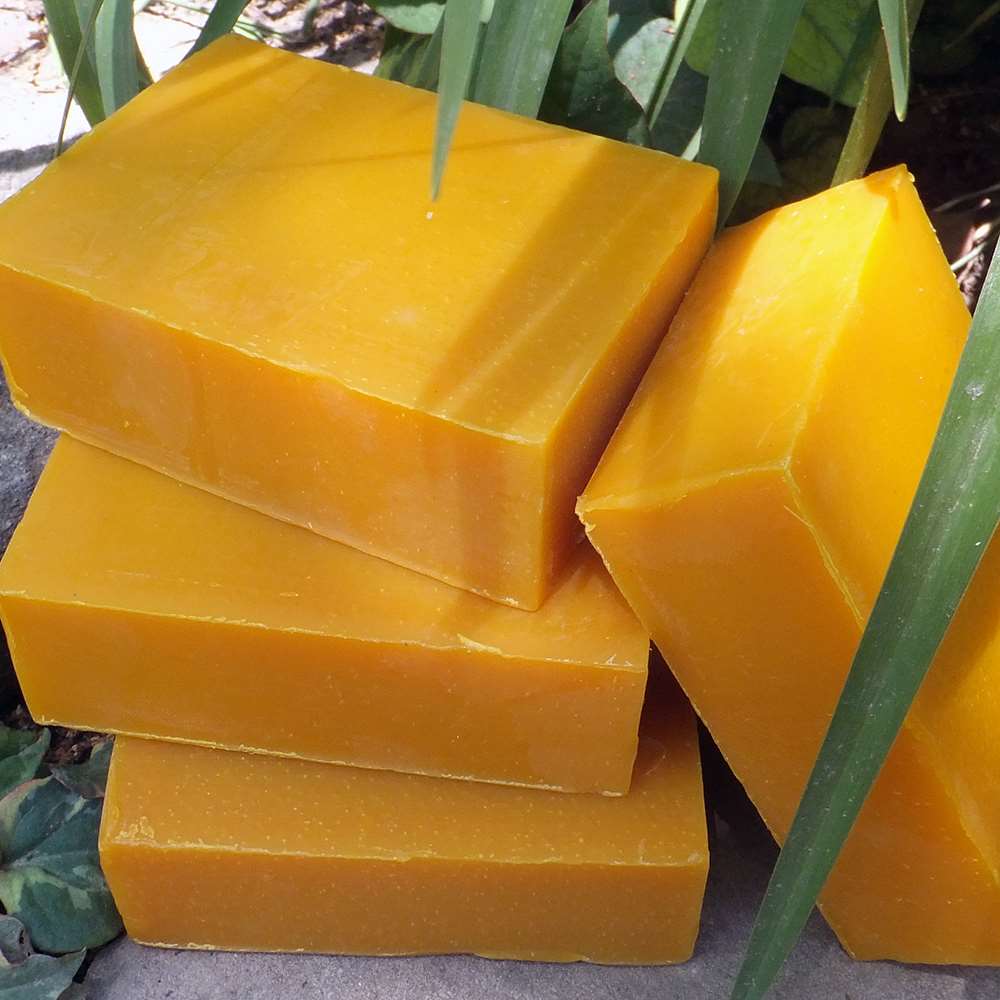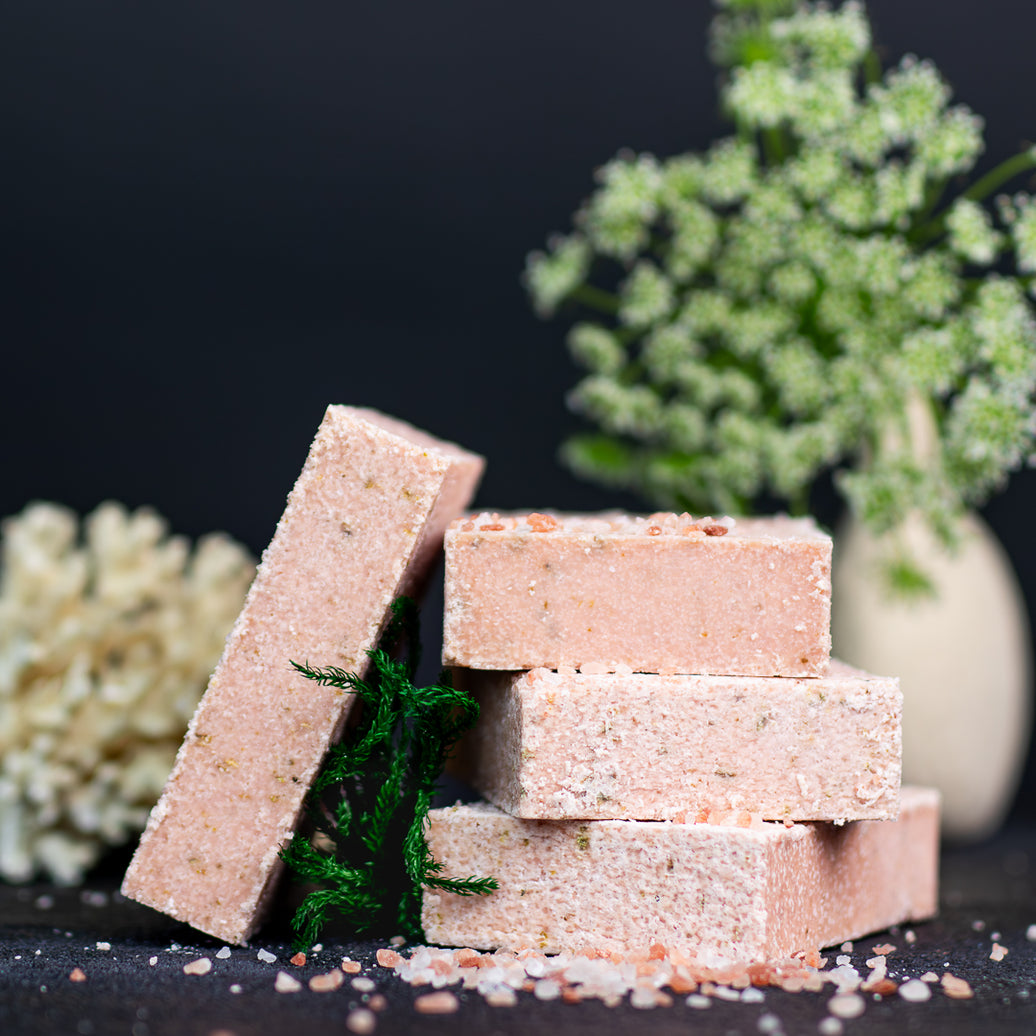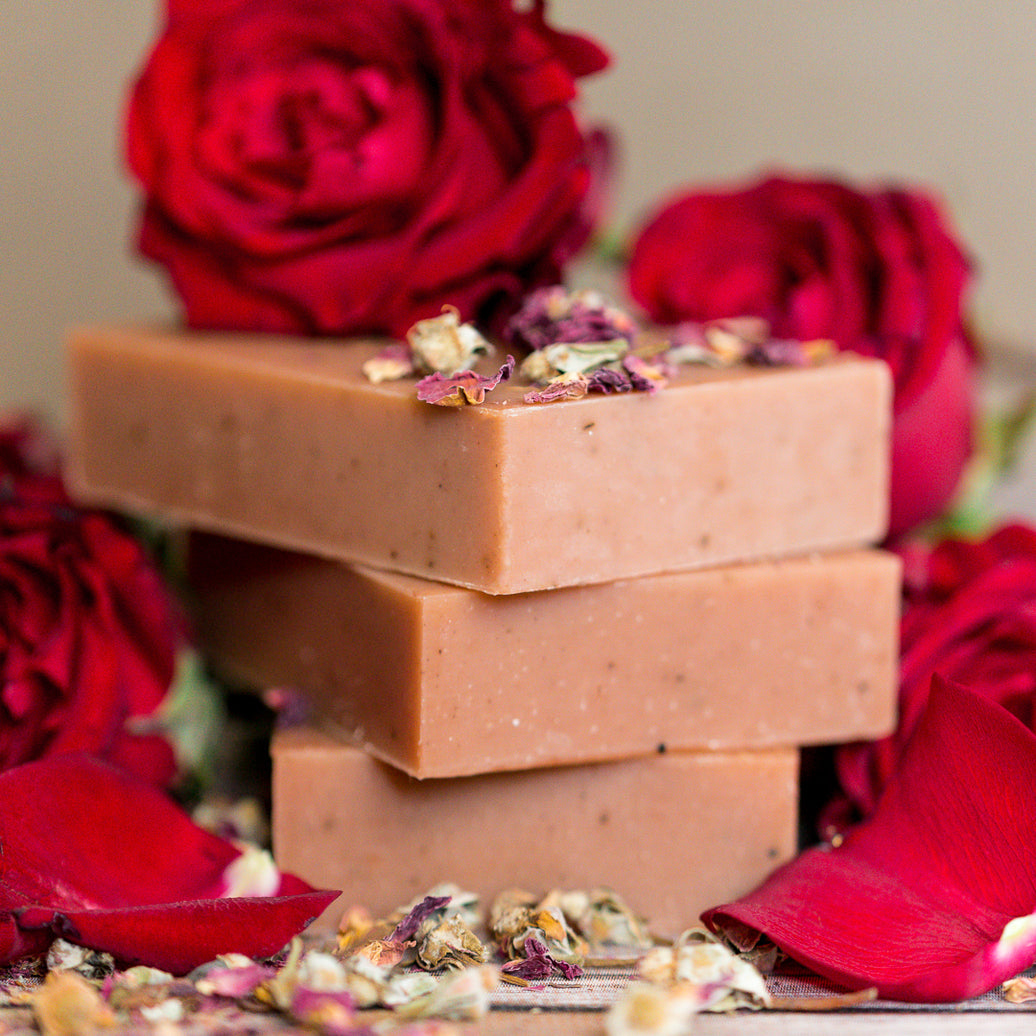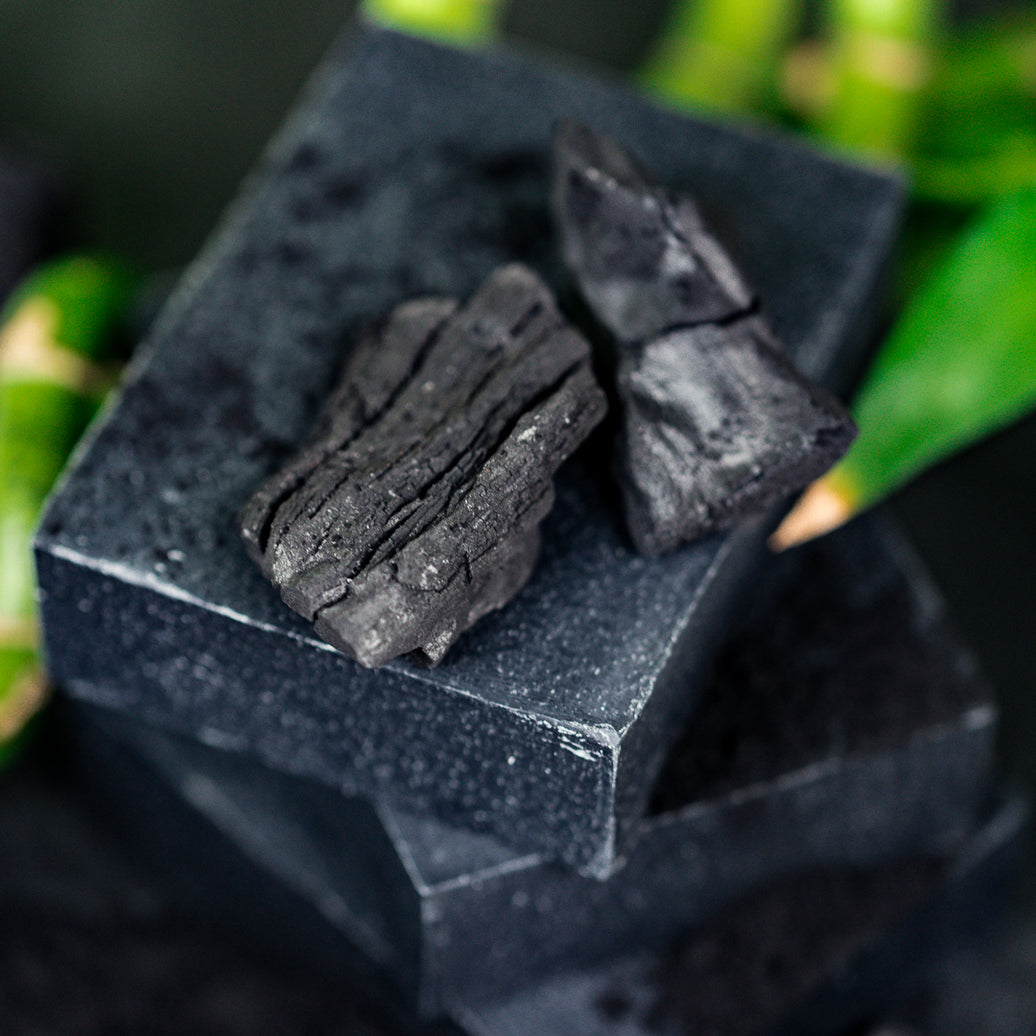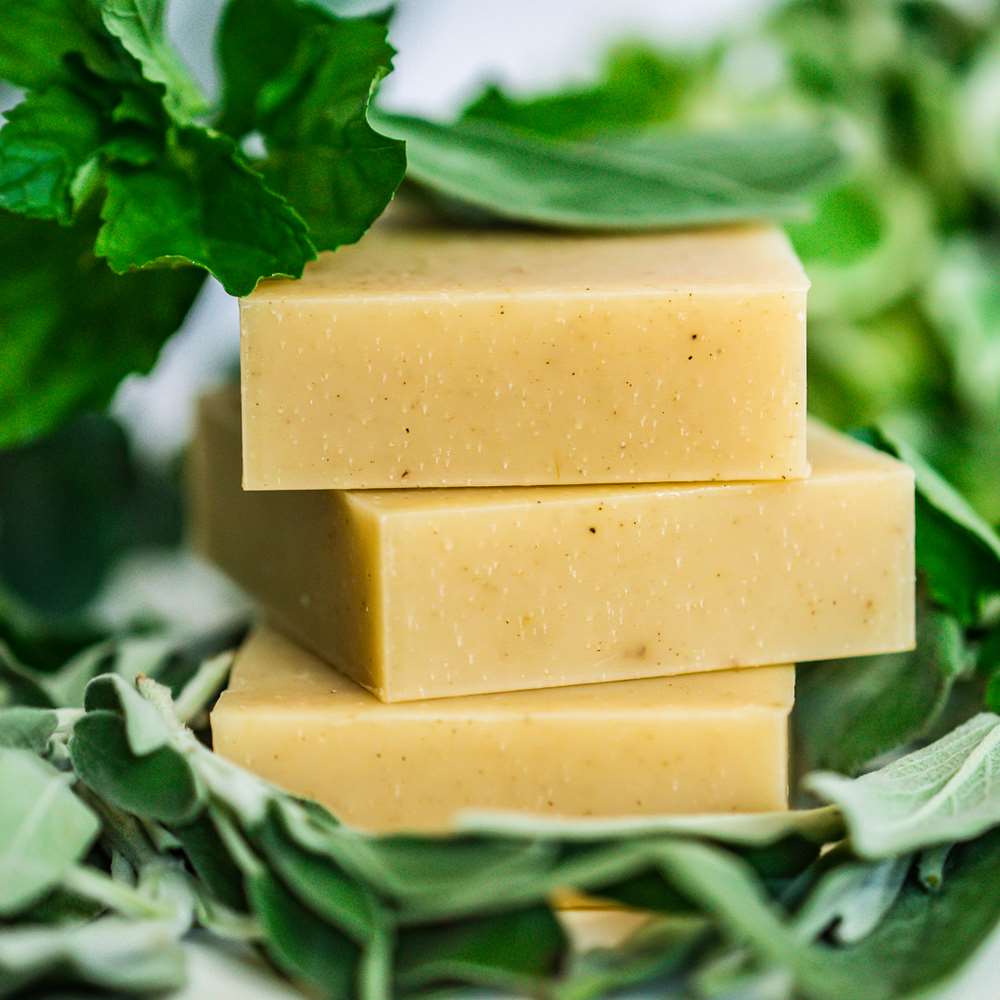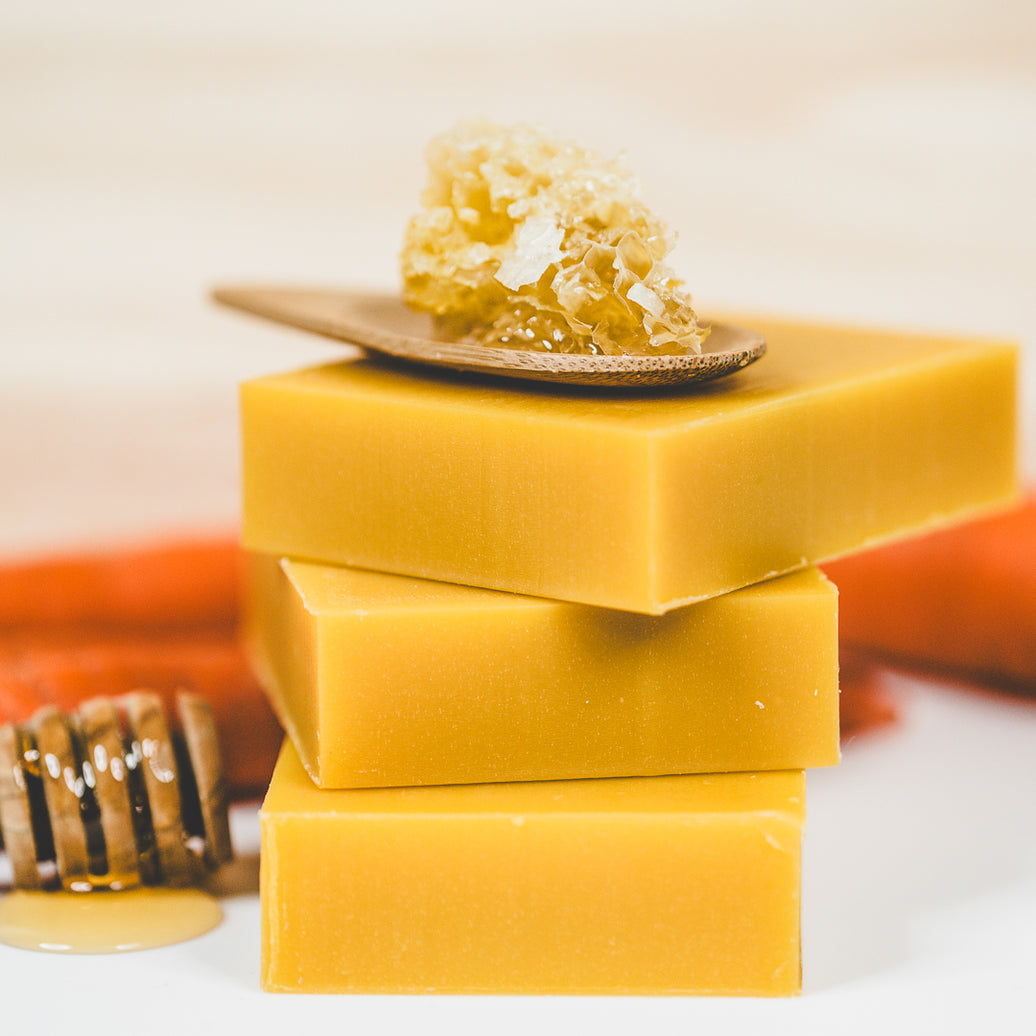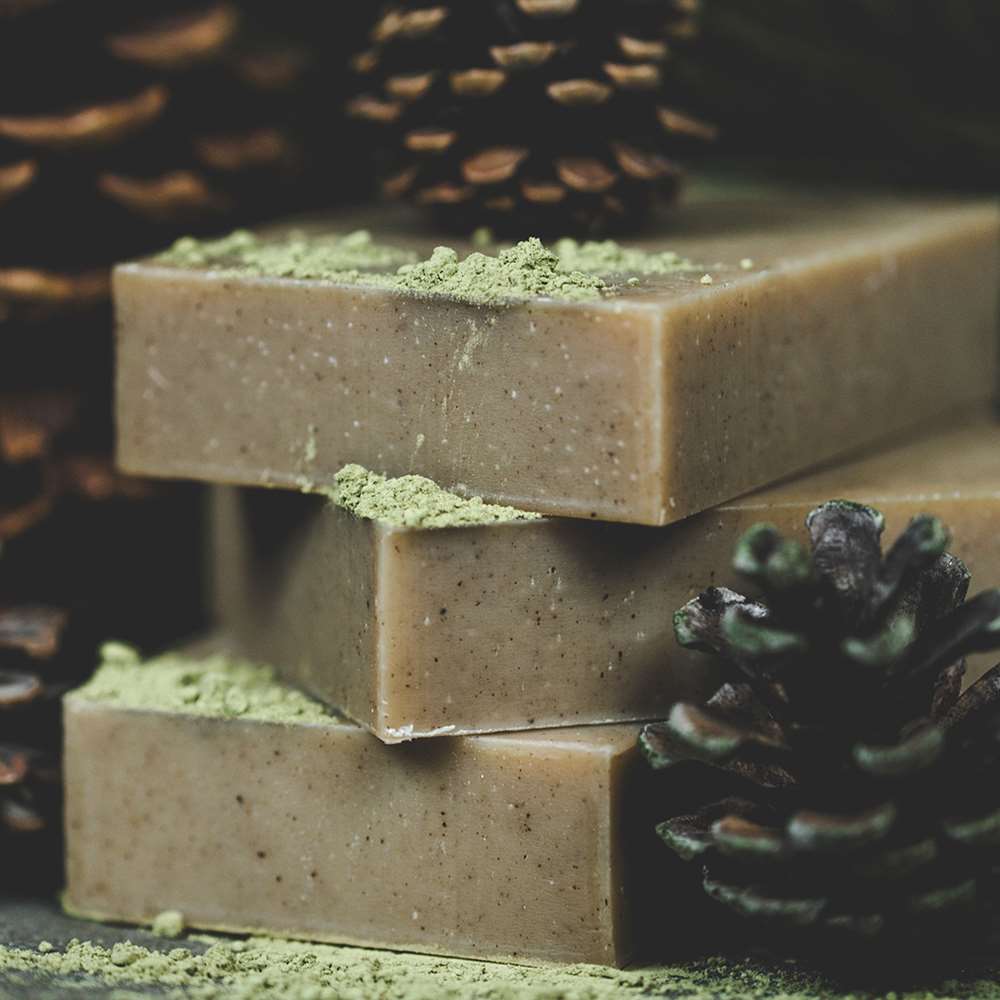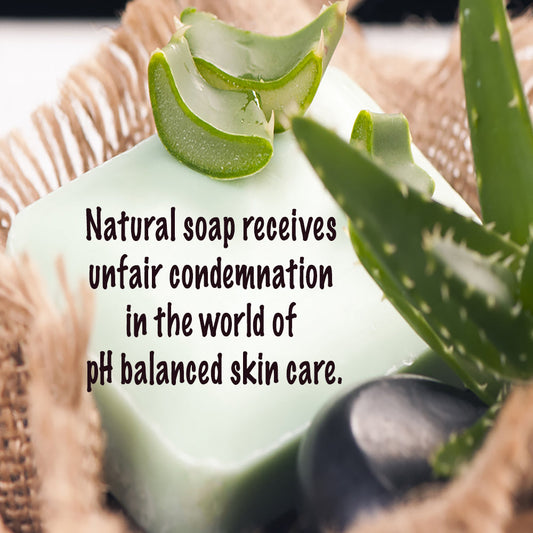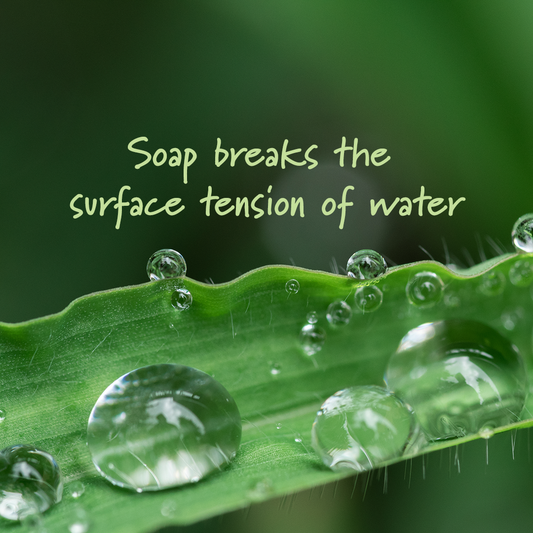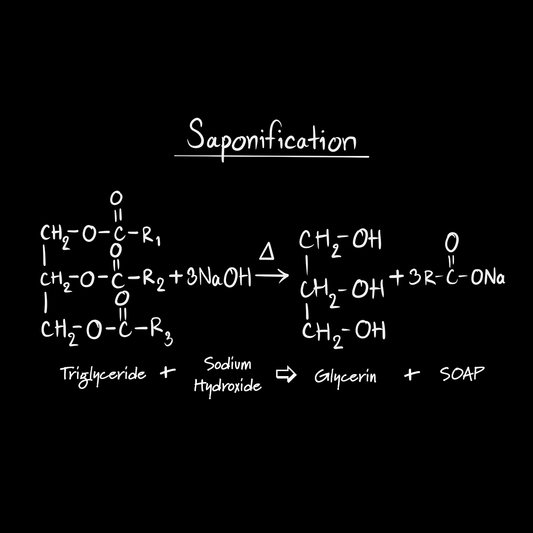Are All Handmade Soaps the Same?
If you Google “Handmade Soap,” you’ll find page after page of large and small companies trying to sell you their version of handmade soap. But are all handmade soaps the same?
The answer is no.
So, What Makes Chagrin Valley Soap & Salve Different?
The truth is, calling a soap “handmade” says nothing about the quality of the ingredients—or the knowledge and skill of the person who made it.
 A label might say “natural” or “hand-poured,” but those words alone don’t guarantee that the bar you are using is good for your skin or the planet.
A label might say “natural” or “hand-poured,” but those words alone don’t guarantee that the bar you are using is good for your skin or the planet.
At Chagrin Valley, our standards are higher. Our commitment runs deeper. And our results speak for themselves.
Experience and Scientific Understanding
Science is at the heart of every bar we create. At age 50, our founder, Ida, launched her third career—building on her experience as a registered nurse, a formal education in Chemistry and Biology, a lifelong love for nature, and a curiosity that sparked what has become over 24 years (and counting) of soapmaking experience. That rare blend of scientific insight, compassionate care, and hands-on craftsmanship is behind every thoughtful formulation we make.
We don’t just make soap—we formulate it with purpose. Every recipe is carefully crafted to blend organic oils and butters in just the right way to create bars that feel creamy in your hands, lather beautifully, and leave your skin soft, clean, and healthy.
Soapmaking is often viewed as an art—and it is—but it is also a precise science.
The secret to creating truly high-quality soap lies in knowing how different oils and butters interact, how they react with lye, and how each ingredient’s unique fatty acid profile influences the bar’s final texture, lather, and skin feel.
Understanding this chemistry allows us to design each soap not just to clean, but to care for your skin in a way that mass-market products simply can not.
Because when you know the science, you can elevate the experience. And that’s what sets us apart.
The Science Behind Exceptional Soap
At Chagrin Valley, every soap and shampoo bar is made from scratch using the traditional cold-process method—a time-honored technique rooted in chemistry.
This method relies on a natural chemical reaction called saponification, where the fatty acids in oils react with sodium hydroxide (lye) to produce soap and glycerin.
Each oil molecule, called a triglyceride, is made up of one glycerin molecule and three fatty acids. These fatty acids vary from oil to oil, and that variation is where the magic begins.
In simple terms, the equation looks like this:
Triglyceride (Fat/Oil) + 3 Sodium Hydroxide (NaOH) → Glycerol + 3 Soap Molecules (Sodium Salt of Fatty Acids)

Once this reaction is complete, no lye remains in the finished soap—only gentle, skin-loving soap molecules and naturally moisturizing glycerin.
But here’s what makes handcrafted soap so special:
This reaction doesn’t happen just once. It happens to millions of triglyceride molecules in a single batch. That means each soap bar is composed of millions of different soap molecules, each one shaped by the unique fatty acid profile of the oils used.
Why does that matter? Because the fatty acids in oils directly determine how a bar of soap behaves on your skin.
- Some produce rich, foamy lather.
- Some create a harder, longer-lasting bar.
- Some condition and moisturize.
- Some cleanse more deeply.
Only by understanding these details can we create a recipe that is truly balanced and effective.
For example:
- Coconut oil owes its luxurious lather to its high lauric acid content.
- Olive oil creates a creamy, gentle bar thanks to oleic acid.
- Shea butter contributes conditioning properties and lather stability due to its oleic and stearic acid content.
At Chagrin Valley, we don’t guess—we know. We formulate every bar based on science. That’s how we strike the perfect balance between cleansing and conditioning.
Because when you truly understand the chemistry, you don’t just make soap. You make better soap.
Learn More Blog: The Chemistry Of Natural Soap Making
Superfat Explained: The Balance That Makes Soap Better
While we love talking about ingredients, there’s more to making a great bar of soap than just what goes in. The recipe, the balance, and the science behind each bar matter just as much.
One of the most misunderstood, but important, concepts of natural soapmaking is something called superfatting.
Each oil or fat has a unique SAP value based on its fatty acid composition. This number tells us how much sodium hydroxide (lye) is needed to turn that specific fat into soap. The SAP value for each soap recipe is determined by all the different oils used to make it. Every recipe needs a precise balance or ratio between fats (oils) and sodium hydroxide (lye).
When the ratio is exact, all the lye is used up during saponification.
 But here’s the problem: if the ratio is too precise, no extra oils are left in the bar. Even worse, a small miscalculation could result in leftover lye, leaving you with a soap that feels harsh, drying, and irritating on your skin.
But here’s the problem: if the ratio is too precise, no extra oils are left in the bar. Even worse, a small miscalculation could result in leftover lye, leaving you with a soap that feels harsh, drying, and irritating on your skin.
Learn More Blog: Is There Lye In Natural Soap? Won't It Harm My Skin?
To ensure our soaps are not only extra mild but also completely lye-free, we use a technique called superfatting.
Superfatting means intentionally adding more oils or butters than the lye can saponify (turn into soap).
These extra oils, called unsaponified oils, stay suspended in the finished bar and are released onto your skin as you wash. Superfatting is expressed as a percentage, indicating the excess oil content relative to the lye amount.
Finding the Perfect Balance
Since each recipe is different, it is all about balance.
Add too much oil and the soap may feel overly greasy or soft, produce less lather, or have a shorter shelf life.
Too little oil and you risk a bar that is harsh or drying. The proper superfat ensures all the lye is used up while leaving behind just the right amount of excess oil.
This highlights the importance of finding the right balance in superfatting to achieve the desired benefits without compromising the soap's quality.
There is quite a bit of debate in the soapmaking world as to “how much” to superfat. Does it just ensure a lye-free bar? Or does it make the soap milder or add hydration?
After conquering the basics of cold-process soapmaking, I began experimenting—adjusting superfat percentages and testing bar after bar. We evaluated how each change affected lather, hardness, and skin feel.
What did we learn?
For most bars, we prefer the skin feel of a higher saponification number. It creates a bar that feels clean but never dry—balanced and nourishing, without being greasy or overly soft.
 While many soapmakers stick to a standard 5% superfat, we prefer a higher superfat. Why? Because we like the silky-smooth feel in our bars.
While many soapmakers stick to a standard 5% superfat, we prefer a higher superfat. Why? Because we like the silky-smooth feel in our bars.
Why We Don’t Share a Superfat Number
We often get asked: “What’s your superfat percentage?”
Here’s the truth: It’s not that simple.
The feel and performance of a soap bar depend on far more than just a superfat number. It all begins with a thoughtfully crafted recipe—one designed from the start with the right blend of oils and butters to deliver specific skin benefits.
We don’t create a more moisturizing bar by simply adding extra oil at the end. We start with skin-loving ingredients like shea butter, olive oil, or sunflower oil, chosen for their conditioning properties.
Likewise, if we want a bar with more cleansing power, we don’t just reduce the superfat—we select oils like coconut or castor for their natural cleansing properties.
A 7% superfat in a bar made mostly with coconut oil will feel very different from a 7% superfat bar made with shea butter or olive oil. It is the entire formulation—the oils, the process, the superfat level, and even the curing time—that determines how a bar feels on your skin.
That’s why we don’t publish a single number. It would not be meaningful without the full context. And honestly, chasing a number often leads to oversimplified expectations.
Instead, we focus on how the soap performs:
- How does it feel on your skin?
- How well does it lather?
- How well does it cleanse the skin?
- How long does it last?
Superfatting is just one tool we use to create an exceptional bar of soap—one that not only works beautifully but feels incredible.
Don’t Be Fooled by Marketing Gimmicks
You may have seen soaps advertised as “Superfatted with Shea Butter.”
Sounds lovely, right?
Unfortunately, it is not scientifically possible to control which oil becomes the superfat in cold-process soapmaking.
Lye does not care which oil you want to save. The lye will react with whatever fats it wants to react with until the lye is all gone. Whatever oil is left becomes the superfat—whether that’s shea butter or something else.
Also, all properly made cold-process soaps made for personal care are superfatted to some degree. So don’t be misled by fancy labels touting “Superfatted Soap” as if it's something rare or extraordinary.
What matters is how balanced and well-formulated the entire recipe is. And that’s where real expertise makes all the difference.
Understanding Soap Curing: Why Patience Matters
Saponification and curing are not the same.
Saponification is the chemical reaction that transforms fats and lye into soap. This process happens quickly—typically 96–99% complete within the first 48 hours. At that point, the soap is technically safe to handle and could even be used.
But just because a bar can be used does not mean it should be.
 The quality of this young soap will be quite disappointing. It may feel harsh on the skin, produce minimal lather, be very soft, and have a shorter lifespan. The true magic of a great bar of soap is patience. Proper curing allows the soap to reach its full potential.
The quality of this young soap will be quite disappointing. It may feel harsh on the skin, produce minimal lather, be very soft, and have a shorter lifespan. The true magic of a great bar of soap is patience. Proper curing allows the soap to reach its full potential.
So, what is curing—and why does it matter?
The curing time for each recipe of cold-process soap is different, and while some think curing is just a time for water evaporation, it is a complex maturation process.
As a soap bar cures, the last of the saponification process comes to a close. As the excess water evaporates, the naturally occurring glycerin becomes more concentrated, which can result in a milder lather and less irritation for sensitive skin. During this time, the soap also hardens and develops its crystalline structure, which contributes to a creamier lather and longer-lasting bar.
Many soapmakers cure their bars for 4 to 5 weeks, but it’s not enough for us.
At Chagrin Valley, our soaps are cured for 8 to 12 weeks, depending on the formula. We believe that a slower, longer curing process produces a milder, longer-lasting bar with a luxurious creamy lather that’s worth the wait.
Want to see how it all comes together?
Check out our blog: How We Make Natural Soap At Chagrin Valley
Handmade From Scratch: No Shortcuts, No Secrets
Not all “handmade” soap bars are truly handmade from scratch.
Some companies use melt-and-pour bases—a pre-made solid soap base that is melted down, customized with additives like botanicals, colorants, or fragrance, and then molded into bars.
Let’s be clear: melt-and-pour soapers can make a nice soap bar. That’s not the issue.
The problem is transparency.
Companies do not tell you they are using a melt & pour base. Instead, they list the ingredients that went into the original base—ingredients that sound just like those in truly handmade soap. As a customer, you would never know the difference from reading the label.
It’s like walking into a bakery and buying what you thought was a scratch-made cake, only to find out it came from a boxed mix. It might taste fine. But you didn’t pay for fine—you paid for something made with skill, care, and quality ingredients.
When you buy handmade, you deserve authenticity.
At Chagrin Valley Soap & Salve, we make every single bar from scratch, right in our own facility, using only raw, carefully sourced ingredients.
We never use pre-made soap bases. We never outsource production. We control every step of the process—from selecting ingredients to the final cure.
Some handmade soap companies even advertise “soap made without lye.” That may sound appealing—until you realize it’s misleading.
You cannot make real soap without lye.
While it’s true that the person making the melt-and-pour soap did not use the lye themselves, the company that made the soap base did. It’s just that someone else handled the chemistry, not the seller.
Handmade Soap Does Not Mean Natural Soap
When shopping for soap, you often see words like handmade, handcrafted, or homemade used on websites and packaging. These words evoke feelings of care, attention, and small-batch quality—and they do matter. But just because a bar was made by hand does not mean it is made with natural ingredients.
“Handmade” describes how the soap is made, not what’s in it.
There are talented soapmakers who use synthetic ingredients to create beautifully designed bars with vibrant colors and fun scents, like rainbow swirls that smell like cupcakes or watermelon. It is a form of artistry in its own right. And for folks who enjoy bold colors and fun fragrances, those soaps may be perfect.
 But if you are looking for genuinely natural skincare products free from synthetic additives, artificial colors, and lab-created scents, then handmade alone is not enough.
But if you are looking for genuinely natural skincare products free from synthetic additives, artificial colors, and lab-created scents, then handmade alone is not enough.
Look beyond the marketing and the label and read the ingredient list carefully.
Unique Soap Recipes for Unique Skin
Some handmade soap companies use the same base recipe for every bar, then simply swap out the scent or color. But your skin is not one-size-fits-all, and your soap should not be either.
At Chagrin Valley Soap & Salve, we don’t start with a cookie-cutter formula. Each soap and shampoo bar is made with a unique recipe, carefully crafted to address specific needs. Whether your skin is dry, oily, sensitive, or somewhere in between, we believe you deserve a product formulated with your needs in mind.
Of course, we want our bars to be beautiful—but never at the expense of quality. The colors, scents, and textures in our bars come from the earth.
We use certified organic ingredients--herbs and flowers, vegetables and fruits, sustainable oils and butters, and pure essential oils.
Each ingredient has a role to play—not just in how the soap looks or smells, but in how it makes your skin feel and supports the health of the planet.
No matter your skin type or your personal preferences, there’s a bar in our collection that was made just for you.
Please visit our Product Knowledge Base for tips to help choose a Natural Soap for your skin type.
Compare Our Natural Soap Ingredients
A Truly Natural Soap Starts With Truly Natural Ingredients. Skincare products are only as good as the ingredients used to create them.
 We use certified organic ingredients whenever they are available. But unlike many soap companies who claim to use organic ingredients, we don’t ask you to just take our word for it.
We use certified organic ingredients whenever they are available. But unlike many soap companies who claim to use organic ingredients, we don’t ask you to just take our word for it.
As a USDA certified organic company, every ingredient we claim as organic is backed by documentation, audits, and strict oversight. Our USDA certifying agency, OEFFA, ensures that we meet the highest standards. When we say organic, we mean it.
It does not make sense to create a handmade skincare product with ingredients grown using pesticides, from genetically modified crops, or processed with harsh chemical solvents. Yet many companies do—because these ingredients are cheaper, easier to source, and require no transparency, oversight, or certification. But what is easier for them is not better for your skin—or the planet.
At Chagrin Valley, we believe that what you put on your body is just as important as what you put in it.
We do not cut corners. Our soapmaking oils and butters are USDA certified organic and cold-pressed, and many are unrefined. Unrefined oils retain more of their natural, skin-loving nutrients. These are the types of raw, nutrient-rich ingredients your skin recognizes and responds to.
Many of our bars are enriched with natural emollients like Shea, Mango, and Cocoa Butters, not in trace amounts for label appeal, but in generous proportions that actually do something for your skin.
Learn More Blog: Rules for Organic Soap Labeling
The Magic of Infused Oils
Some of the magic in our soaps comes from the herbal-infused oils we use to make them.
Slowly infusing herbs into oil is one of the oldest and most beautiful forms of medicine-making.
Over time, the gentle infusion process draws out the plant’s healing properties, scent, and color, transferring them into the oils we use to make our soap.

Infused oils allow us to create bar soaps that are not just cleansing. You will find everything from calendula and chamomile to comfrey and plantain in our infusions, all chosen with purpose and backed by tradition and science.
And because the herbs are infused into the actual soapmaking oils—not just tossed in at the end—you receive the full benefit of their natural properties in every bar.
Whole Plants: Nature's Full Symphony
Whole plants offer a natural synergy—skincare in harmony with nature. They deliver a complex interplay of compounds that supports skin health in ways no single extract can.
Take calendula, for example. This golden flower contains a rich mix of antioxidants, flavonoids, and natural oils. While it is possible to isolate one single compound, like a specific antioxidant, using the whole flower means your skin receives the full spectrum of its soothing benefits. We believe these natural compounds work best together, calming inflammation, supporting healing, and nourishing the skin in ways an isolated extract simply can not replicate.
It’s a bit like listening to just the violins in a symphony. Beautiful, yes—but missing the harmony, depth, and complexity of the full orchestra. That’s what whole-plant skincare offers: nature’s full composition, working in concert for your skin.
Real Ingredients. Real Soap. Real Benefits
We make great soap for the body, face, shaving, babies, and even pets. Each bar is made the way it should be made—using ingredients from nature, not a lab.
- Our soaps are colored with botanicals, herbs, spices, juices, clays, and teas—not synthetic dyes.
- Our scents come from pure essential oils—not artificial fragrances or “nature identical” oils.
- We use real pumpkin in our seasonal Pumpkin Spice soap, not just a synthetic pumpkin spice scent.
- We use real chocolate, real beer, real coffee, real tomato juice—because we believe your skin deserves the real thing.
- Our rich, creamy lather is produced by natural oils like coconut, babassu, and castor bean.
- Our fruit soaps contain real fruit, juice, zest, and fibers.
- Our floral soaps are infused with real botanicals and essential oils.
- Our herbal soaps are made with herbal-infused oils that are crafted with the same care as every other ingredient we use.
We do not skimp on the quality or quantity of ingredients used in our bars. Other soap companies may advertise fancy ingredients, but look closely. If their Dead Sea Mud soap is white, how much mud can really be in there? If sea buckthorn oil doesn’t give the bar a rich orange hue, is it just a drop or two for show, or are they using only extracts?
At Chagrin Valley, we believe ingredients should look, feel, and work like the real thing—because they are.
Natural Colors and Scents: Pure and Simple
 Truly natural soap is not hot pink or glittery. It does not smell like bubble gum or cotton candy.
Truly natural soap is not hot pink or glittery. It does not smell like bubble gum or cotton candy.
Instead, it reflects the warm, earthy hues of real ingredients—and the grounding, refreshing scents of organic essential oils that offer true aromatherapeutic benefits.
Artificial colors, synthetic fragrances, and even so-called “nature-identical” scents may be cheaper and more consistent, but they don’t belong in a product called natural.
At Chagrin Valley, we choose to work with nature’s palette: spices, juices, herbal teas, plant-infused oils, and other real, natural ingredients. Yes, they are more subtle, more seasonal, and sometimes even unpredictable—but they are authentic.
Our soaps may vary slightly from batch to batch, and that is not a flaw—it is part of the beauty of truly handmade, truly natural skincare.
Want to see the difference? Pick up one of our soaps, read the ingredient list, and compare. You’ll know exactly what you’re putting on your skin—and why that matters.
Soap Labeling and Transparency: What You Need to Know
Did you know that soap companies are not required to list their ingredients?
Under FDA rules, a true soap is defined as a product primarily made from the “alkali salts of fatty acids”—in simple terms, soap created by combining lye with oils or fats.
If a product contains synthetic detergents (even if labeled "soap"), it is legally classified as a cosmetic, not a true soap.
Here’s where it gets important for consumers. For true soap, the labeling rules are surprisingly light.
- True soaps are exempt from the FDA’s cosmetic regulations.
- Their labeling falls under the Fair Packaging and Labeling Act (FPLA), which only requires the product name, net weight, and the name and address of the manufacturer, packer, or distributor on the label.
- Listing ingredients is not legally required for true soaps. And if a company chooses to list ingredients, they are not required to include all of them or list them in order of predominance by weight.
- There is no legal obligation to disclose fragrance blends, color additives, or other components.
 What does this mean for you, the consumer? When buying soap, you may have no real way of knowing:
What does this mean for you, the consumer? When buying soap, you may have no real way of knowing:
- What ingredients are truly in the bar
- How much of each ingredient is used
- Whether added fragrances and colorants are synthetic or natural
At Chagrin Valley Soap & Salve, we believe you deserve better, and because we are USDA Certified Organic, we don’t just choose to list our ingredients—we are:
- Required to list every single ingredient—no exceptions.
- Required to list ingredients in descending order by weight.
- Subject to regular audits and inspections to verify compliance with USDA organic ingredient standards.
Our ingredients are not just words on a label. They are monitored, verified, and certified. When you pick up one of our bars, you can feel confident that the label tells the real story, not just what’s convenient for marketing.
Our Commitment Goes Beyond Ingredients
We are more than just a soap company. We are gardeners, scientists, and environmental stewards—deeply rooted in a mission that respects people and the planet. We are committed to more than just great products. Our soaps are crafted with environmentally friendly practices and ingredients, so you can feel good about what goes down the drain.
Many companies talk about sustainability, but for us, it is not a marketing strategy—it is a way of life. It guides how we live, how we create, and how we do business every single day.
We prioritize sustainability because how a product is made—and what it leaves behind—matters as much as how it feels on your skin.
At Chagrin Valley Soap & Salve, environmental stewardship is not a buzzword. It is not a trend, a political stance, or something we adopted because it became popular. It has always been at the heart of what we do.
We use:
- Fair Trade and sustainably sourced ingredients
- Certified Sustainable palm oil
- USDA Certified Organic ingredients sourced sustainably
- Cruelty-free ingredients and practices, certified by Leaping Bunny
- Minimal, 99% plastic-free packaging
We make these choices not because they are easy or because we have to, but because they are right.
The value of our products goes beyond the label. They are not just natural—they are made with purpose and care. From ingredient to finished product, every decision is guided by a deep respect for the Earth and all its creatures.
From biodegradable formulas to sustainable packaging, we continuously work to minimize our footprint and promote a healthier environment.
Learn More: Chagrin Valley Environmental Commitments
Compare Our Soap Bar Size: Bigger Bars, Better Value
Yes, our bars are bigger than most—but that’s just the beginning of the story.
While many handmade soap companies sell bars weighing just 3.5 to 4 ounces, our bars start at a generous 6.5 to 7 ounces when freshly cut.
Then comes the magic of our slow, 8 to 12-week curing process. During this time, excess water naturally evaporates, allowing the bar to harden, last longer, lather better, and become milder. After curing, our bar weight decreases to 5.5 and 6.2 ounces, still larger than most!
Here’s the part many people don’t realize: A soap bar with a shorter cure time may still contain a lot of excess water, and water adds weight. Let that same bar sit in your home for a few more weeks, and you will notice the shrinkage.
We never rush this process. Why? Because we believe a longer cure means better soap—harder, longer-lasting, and full of that rich, creamy lather your skin will love.
 So don’t just compare prices—compare the weight, the ingredients, and the curing time. You are not just getting more soap—you are getting better soap.
So don’t just compare prices—compare the weight, the ingredients, and the curing time. You are not just getting more soap—you are getting better soap.
Conclusion: The Heart of What We Do
We make handmade natural soap.
We did not invent the process, but we do it with intention, integrity, and a respect for tradition that is rare today.
Every bar is made from scratch in small batches by people who believe that what you put on your body should be as honest and nourishing as what you put in it.
Soapmaking, for me, is where science meets art—a craft that took years to refine. It’s not fast, it’s not flashy, and it’s never about shortcuts or gimmicks. We create every recipe with purpose, guided by a passion for skin health and ingredient integrity.
Every detail matters. From the oils and butters we choose to the superfat level, from how we mix and pour to the time we take to cure each batch—none of it is left to chance.
Our ingredients are not chosen for label appeal, but for how they work together to create a bar that feels good in your hands, is gentle on your skin, and reflects the care and intention behind everything we make.
In the end, it’s simple: we do this because we believe it matters.
We believe that real natural matters. That transparency matters. That the choices we make—about ingredients, about packaging, about process—matter.
And we believe you deserve a product made with care, by a company that truly means what it says.
In a world full of noise and misleading labels, we hope our soap feels like something different—something honest, something real.
From our family to yours—thank you for supporting something real.

How We Make Soap At Chagrin Valley
Is There Lye In Natural Soap? Won't It Harm My Skin?
How Does Natural Soap Create Lather?
12 Reasons To Use Natural Soap
Find the Perfect Handmade Soap for You
This blog, originally published in 2014, has been updated for content
